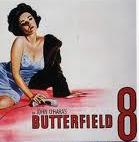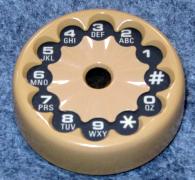
I remember as a child (although perhaps a child with an unusually analytic mind) wondering how it was possible for me to call anyone in my town. Were there telephone wires running from my house to every other house? I hadn't conceived of the idea of a telephone "exchange", a single point to which wires from all the nearby houses ran. There, the operators could connect the wires from my house to the wires from any other house. If the number called was not in your exchange, the operator would have to connect the circuit to another exchange so that a different operator could complete the call. When the connection was finally established, the two phones were linked by actual copper wires.
It's said that the early telephone companies tried using young men as operators, but they were often rude to customers. Women did a much better job, so "telephone operator" became a female job. I should point out that in my youth, sex discrimination was the norm. Newspapers advertised "Help wanted - men" and "Help wanted - women", and it was perfectly legal and routine. Doctors were mostly men, nurses were almost always women, and that's the way it was. We didn't give it a second thought You could save money by buying a "party line", or you might be forced to use one because of a shortage of lines in your area (I think my family briefly had a party line when we first moved to Great Neck, NY). In that case, two or more customers shared a single line. It was like having multiple extension phones in a single house, but these extensions were in different houses. A call's destination was determined by the number of rings, and there was nothing to stop the other parties from listening in.
So you put your finger in the desired hole in the dial face, and swung the dial until your finger hit the stop. You then pulled your finger straight out, leaving the dial free to rotate back to its rest position. The mechanism rotated at a slow, uniform speed, effectively hanging up the phone (but only very briefly) a number of times proportional to the amount the dial had been rotated (generating from one to ten pulses at a rate of ten pulses per second). At the telephone exchange, these pulses ratcheted a mechanical relay called a "Strowger switch" to a position determined by the number of pulses sent. When we dialed "INgersol 2 - 3410", we dialed only the first two characters of "INgersol". Only the "IN" mattered, corresponding to the two digits 4 ("GHI") and 6 ("MNO"). People still used the rest of the exchange name as a mnemonic, though - they would still give the number as "INgersol 2 - 3410".
As with any interface to a machine, the use of the telephone dial was not quite as obvious to the world as its designers might have hoped. People had to be taught, for example, to pull their finger straight back out of the hole after it hit the stop. Without that instruction, they would sometimes leave their fingers in the hole as the dial swung back to its resting position. After all, they had their finger in the hole on the clockwise rotation of the dial, so why not keep it in the hole for the return trip as well (especially if you were going to dial the same digit twice)? But for the phone to send out properly timed pulses of the proper duration, the dial had to be allowed to swing back freely on its own. Note 2 Another peculiar problem occurred in certain areas only - lots of mis-dialed numbers with digits permuted. It turned out that the problematic areas were German speaking, many of them in the state of Pennsylvania. Consider a number like "29", for instance. In English, we read that as "twenty nine", but in German, it's read as "neun und zwanzig", which word for word is "nine and twenty". German speakers tended to enter this as "92", since the nine is said first. An education campaign had to be undertaken to teach them to enter the digits in the order they were written, not the order in which they were spoken. Telephone billing changed over time. Initially, every call you made was itemized on your bill, and the rate (per minute) charged for each call increased with distance. Later, a flat monthly rate might be charged for local calls within your own exchange and neighboring exchanges, but there were still itemized charges for calls outside those zones, and particularly, for "long distance" calls. It was interesting to see the changes in fees for cellular phones mimic the changes that had long ago occurred for wired phones. Before the advent of "Direct Distance Dialing" in 1951, "long distance" calls, especially inter-state calls, required operator assistance. When I was a counselor-in-training at Camp Robinson Crusoe in the late fifties, I recall placing long distance calls for campers. This was done by dialing "0" (zero) to get an operator, and asking for a number in a particular city or town. The location was requested by name - there were no "area codes", and all numbers were only seven digits long. When placing the call, I also asked the operator to call back after the call ended, to tell me the charges, so they could be passed on to the camper's account. I could often hear the local operator contact a special "long distance" operator, and say things like "request a routing for Great Neck, New York, HUnter-2". The long distance operator would return a cryptic string of letters and numbers which, I gather, allowed the call to be connected from exchange to exchange, until it arrived at its distant destination. Long distance calls had a rather hollow, echoing sound to them, due to an inability to exactly compensate for the distributed capacitance of the long wires, and imperfections in the multiple amplifiers needed along the connection. Note 3 Eventually, low-cost transistor circuits made the "touch-tone" telephone possible, but these weren't introduced until late 1963, the year I graduated college, and many years passed before they became commonplace. They use a technology called DTMF, which stands for Dual Tone Multi-Frequency. But when my children were young, in the late seventies and early eighties, we still had dial telephones, partly because the telephone company charged extra for touch-tone use, and the advantages weren't obvious (just slightly faster dialing).
By the way, we were also able to purchase telephones with buttons instead of dials. All phones have a switch on the side labeled "pulse" or "tones". If the switch is in the "pulse" position, the phone generates perfectly timed pulses equivalent to those generated by a telephone with an actual dial. When we finally purchased touch-tone service (I think when the extra charge was dropped), we simply flipped the switches on all our telephones to the "tones" position. My next entry, "Telephones (bis)", has more to say about the history of telephony leading up to the era of the iPhone shown at the beginning of this entry. Note 4 I don't have one, by the way. For all its wonderful features, there is one negative point I've heard about the iPhone - it's been said that it's not really a very good telephone.
  Note 1: My friend and MIT classmate Martin Schrage read about "Ingersol 2 - 3410", and noted, "Boy, you lived in the BIG city. When I wanted to call my parents' business in Gainesville, Georgia, I would say: 'nine-five-oh' in response to 'number please'." Well, I DID live in the big city, or at least alongside it. "Ingersol 2" was an exchange in New York City, much, much larger than Gainesville, Georgia. Martin added, "Given that even in Gainesville each operator was unable to have a few thousand jacks within reach, how did she connect you to a jack on another operator's board? I used to worry about this at an early age, and I still have no idea. There is something about trunk lines? Did she light up someone else board and verbally give her the desired number?" I don't know how trunk lines worked either. [return to text] Note 2: Martin also reported, "Circa 1993, we were visiting my parents in Gainesville with Seth, who was about three years old. He toddled into the living room and proudly announced that he had learned how to use the old-fashioned dial phone in the guest bedroom." [return to text] Note 3: Again from Martin: "The first long distance call was from Boston to Salem. In Salem, there was a loud speaker set up in a lecture hall, and people assembled to hear Mr. Watson from Boston. There is a plaque in Salem. It seems unfortunate that there is no comprehensive exhibit about how the telephone was developed here in Boston." There is a commemorative marker in Boston at 109 court street, the location where Alexander Graham Bell first transmitted sound over wires. There's also a plaque at 710 Main Street in Cambridge, Massachusetts commemorating a three-hour "long distance" telephone conversation between Bell and Watson, "long distance" in this case meaning between Boston and Cambridge (which are just across the Charles River from each other). Three hours! And they weren't even teen-agers! [return to text] Note 4:
If you haven't seen David Pogue's Music Video about the hype surrounding the introduction of the iPhone, click that link. [return to text]
 |
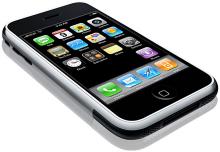 The Apple iPhone® is a "smart" cellular telephone of today (early 2011). It's actually a powerful computer, many thousands of times more powerful than the IBM 704 vacuum-tube based mainframe computer that filled a room in the computer center when I arrived at MIT in 1959. The iPhone has a multi-touch graphical user interface, and includes a microphone, speakers, and a camera. It communicates using either a cellular telephone network or short-range "WiFi" radio links, and includes an internet browser. It fits in your shirt pocket.
The Apple iPhone® is a "smart" cellular telephone of today (early 2011). It's actually a powerful computer, many thousands of times more powerful than the IBM 704 vacuum-tube based mainframe computer that filled a room in the computer center when I arrived at MIT in 1959. The iPhone has a multi-touch graphical user interface, and includes a microphone, speakers, and a camera. It communicates using either a cellular telephone network or short-range "WiFi" radio links, and includes an internet browser. It fits in your shirt pocket.
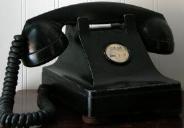 In contrast, the picture to the right shows what many telephones looked like when I was a young child in the forties. It had to be connected to a telephone exchange by wires, of course. When you picked up the handset, an operator said, "Number, please", and you stated the number you wanted to reach.
In contrast, the picture to the right shows what many telephones looked like when I was a young child in the forties. It had to be connected to a telephone exchange by wires, of course. When you picked up the handset, an operator said, "Number, please", and you stated the number you wanted to reach. 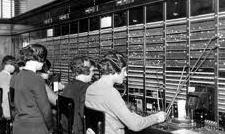 The connection was made at a large board called a "switchboard", like the one in the picture (shown as it was around 1930). The wires from each telephone came up on the board at a circular "jack" (the "female" connector), whose position on the board corresponded with its associated telephone number. These were connected by two linked "plugs" (the "male" connector), one plugged in to each jack to complete the call.
The connection was made at a large board called a "switchboard", like the one in the picture (shown as it was around 1930). The wires from each telephone came up on the board at a circular "jack" (the "female" connector), whose position on the board corresponded with its associated telephone number. These were connected by two linked "plugs" (the "male" connector), one plugged in to each jack to complete the call.
 Our phones used to be wired to the wall with screw terminals. The modern "modular" telephone connector didn't appear until around 1976. A modern telephone connector is shown to the right- it's called an RJ11 connector. If you look closely at one, you'll see that it actually has six potential wiring positions, although most often, only the center four, numbered 2 - 5, are used. Positions 3 and 4 are called "Ring" (red wire, negative voltage) and "Tip" (green wire, positive voltage), respectively, and are used for the main telephone line on the circuit.
Our phones used to be wired to the wall with screw terminals. The modern "modular" telephone connector didn't appear until around 1976. A modern telephone connector is shown to the right- it's called an RJ11 connector. If you look closely at one, you'll see that it actually has six potential wiring positions, although most often, only the center four, numbered 2 - 5, are used. Positions 3 and 4 are called "Ring" (red wire, negative voltage) and "Tip" (green wire, positive voltage), respectively, and are used for the main telephone line on the circuit.
 Since the RJ11 is a telephone connector, you might think that the wire designated "Ring" had something to do with making the phone ring. You would be wrong. These names come from the corresponding positions on the plugs used on the old telephone switchboards, like the one shown to the left - the three connection points were called "Tip", "Ring", and "Sleeve". Tip and Ring carried the telephone line, and the Sleeve was just a protective ground. Thus the names of the wires on a modern telephone connector come from the physical positions to which those wires connected on an obsolete switchboard plug.
Since the RJ11 is a telephone connector, you might think that the wire designated "Ring" had something to do with making the phone ring. You would be wrong. These names come from the corresponding positions on the plugs used on the old telephone switchboards, like the one shown to the left - the three connection points were called "Tip", "Ring", and "Sleeve". Tip and Ring carried the telephone line, and the Sleeve was just a protective ground. Thus the names of the wires on a modern telephone connector come from the physical positions to which those wires connected on an obsolete switchboard plug.
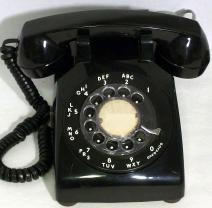 It was not long before the process of completing a call was automated, and dial telephones like the one shown to the right arrived on the scene. It's still common to speak of "dialing" a telephone number, even though many younger phone users have never seen an actual "dial" in their lives. Dial telephones go back to a time when digital electronics didn't exist, and from an engineering point of view, the cheapest way to do something like generate a train of pulses was to do it mechanically.
It was not long before the process of completing a call was automated, and dial telephones like the one shown to the right arrived on the scene. It's still common to speak of "dialing" a telephone number, even though many younger phone users have never seen an actual "dial" in their lives. Dial telephones go back to a time when digital electronics didn't exist, and from an engineering point of view, the cheapest way to do something like generate a train of pulses was to do it mechanically.
